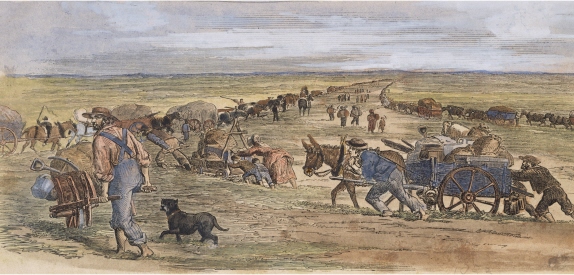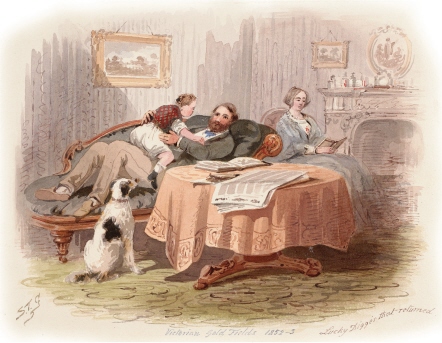The Forgotten Rebels of Eureka (20 page)
Read The Forgotten Rebels of Eureka Online
Authors: Clare Wright
Tags: #HIS004000, #HIS054000, #HIS031000

Alarming Prospect: all the single ladies. John Leech, 1854.

Head down, bum up on the road to Ballarat. John Alexander Gilfillan, 1853.

Great expectations: the lucky digger returns. S. T. Gill, 1852â3.

Grass widows: the girls the diggers left behind and what they had to do (detail). William Strutt, 1851.
Martha Clendinning was a woman
who knew her own noddle. Like Frances Pierson, she was not content to remain in Melbourne while her husband went to the diggings. When Dr George Clendinning announced his imminent departure to Ballarat in the autumn of 1853, Martha
declared her intention
to accompany him. She was thirty-one years old; George was sixteen years her senior, but Martha would not be cowed.
I had made up my mind
, she declared. She would go to Ballarat, and so would her five-year-old daughter, Margaret, and Martha's younger sister, Sarah Lloyd, despite Sarah's husband's objection that there were
no decent women there, only a few of the Vandies' wives
. Tom Lloyd repeated the judgment of men throughout the ages when they didn't want to share their self-proclaimed territory. The goldfields were
no fit place for any respectable woman
.
The husbands went to scout the fields for the most promising tent site, and Martha and Sarah got to talking.
After they had left us women
, wrote Martha in her reminiscences,
we had discussed our future life at the diggings and we at once came to the conclusion that we never could sit down in our tents there with our hands before us
. Martha was pragmatic.
Our house work (if I may use the term) would take up very little time, and there was but one child between
us to attend to
. Martha was also shrewd.
Besides finding something to occupy our time, we felt we should much like some way of making a little money to help our husbands in their hard work.
The Doctor, as Martha called her husband, was intending to dig for gold, not to practise medicine. Since few people got rich overnight, he might need some help at first, even if he would not countenance the idea now. And after all, at forty-seven he was not a young man. But what could two well-bred Anglo-Irish girls, scions of the Protestant Ascendancy, do to earn a livelihood?
Teaching and needle-work, the usual womanly employments, were out of the question; they were not needed on the gold fields
, mused Martha.
At last the happy thought struck us. We would keep a store! A nice, tidy, little store! We were well pleased with the idea.
Martha and Sarah conveyed their joyous plan to their husbands. The men greeted the proposal
with peals of laughter
. They'd be the laughing stock of the diggers, they said. What did a couple of women know of business, they said. You'll be cheated and mocked, they said. So Martha and Sarah said tosh!
We were disgusted at the reception
, remembered Martha years later. The sisters kept to their plan, even amid the derision of their husbands, who maintained
a quiet sense of our excessive folly
. What George did not realise was that moonlighting to support their husbands was commonplace among Ballarat wives. Being financially dependent on his wife was just one more way in which The Doctor was about to become an ordinary digger.

By January 1854, the Ballarat goldfields rattled with industry and hummed with domesticity. The public and private spheresâwhose separation was such a Victorian-era idealâwere as permeable here as a candlelit tent. Summer was in full flight, taking its toll on a community that lived in, by and for the elements. A
tremendous blow of hot wind blew down to pieces a great many tents
, wrote Thomas Pierson on 5 January. Living in those flailing tents were 6650 women, 2150 children and 10,700 menâalmost twenty thousand inhabitants. Though Castlemaine and Sandhurst (Bendigo) maintained greater populations in the summer of 1853 (21,225 and 26,500 respectively), Ballarat had the highest proportion of women: forty-five per cent of Ballarat's inhabitants were women and children, compared with twenty-three per cent at Castlemaine and thirty-one per cent at Bendigo. Even these latter percentages are a far cry from William Withers' depiction of the
womanless crowds
of the first year of the gold rush. Of the overall goldfields population of 80,000 in January 1854, one in every three people was a woman or child.
1
In Ballarat in 1854, gold digging was inextricable from breadwinning.
Newcomers to the diggings knew to expect that women and children would be there in numbers. You only had to open your eyes. The Ballarat correspondent to the
GEELONG ADVERTISER
wrote on 25 July 1854 of the romance of the old days when the
only amusement to be derived was from gazing at tall stringy-barks
. Now, he wrote,
it refreshes one to look back on a time when the black police kept watch and ward over adventurous ladies who had come to see the diggings, and whose arrival on the old Golden Point was greeted with a three times three
. These days, he sighed, the coach
brings up its hundreds of the fair sex, and not a solitary cheer greets its arrival
.
One fellow wrote home in late 1853 that
there are not less than 20,000 men gold digging, besides women and children, all of whom two months ago were in Melbourne or Geelong
. The correspondent's next comment was probably more fanciful than observational. The diggers are
clothing their wives and children in silks and satins
, he wrote.
2
The image of heroic husbandry, as we have seen, was a central symbol in the gold rush iconography. Chivalrous benefactors were supposed to be the saviours of the day.
But when William Howitt visited the goldfields in 1854, the damsels did not appear to be distressed.
There are some hugely fat women on the diggings
, he wrote,
the life seems to suit them
. They seemed to enjoy the outdoor existence, adapting to its conditions. The women were not swathed in finery, but rather dressed in a fashion that suited a life of toil.
A wide awake hat, neat fitting jacket, handsome dress
, observed Howitt;
a costume quite made for the diggings
. It needed to be. In the mornings, Howitt saw women and girls hanging out the wash, cooking over campfires and
chopping wood with great axes which swung them
. They kept chickens and goats. These
diggeresses
, he concluded, provided
a certain stationary substratum beneath the fluctuating surface
. Women had quietly become the bedrock of the Victorian mining communities.
Englishman William Kelly, who had previously written books about the Californian goldfields before touring Australia in 1853 and 1858, noted that a remarkable feature of the Ballarat diggings was
the large proportion of women
. American research reveals that only three per cent to ten per cent of the âforty-niners' were female, clearly a much smaller proportion than in Victoria.
3
(In California women's presence on the goldfields was greeted with hostility by men, who believed that women foretold an end to male camaraderie. There was a common axiom: when the women and Jews arrived, it spelled the end of the good old days.
4
) If the Californian diggings weren't an exclusively masculine terrain, men were certainly a more predominant force than in Victoria, and this would have important implications for the respective political destinies of the two frontier outposts.
Kelly noted the upside of this female presence in Ballarat.
The Californian digger had to roast, grind and boil his own coffee
, he wrote,
but the Victorian, who is surrounded with women, would be saved all that bother.
It's tempting to leave the quote there but the rest of the passage reveals his true opinion:
I was on the point of writing the softer sex, but that would have been a misnomer for the most callous specimens of the female creation I ever encountered were mere green pulp in comparison with some of the granite-grained viragoes I had the honour of meeting in the âfield of cloth of gold' in the new world.
Kelly preferred the dewy maidens of the old country, with their acquiescent airs and compliant graces; his expectations of what women's presence on the fields should mean were constantly dashed. Other observers also felt compelled to mention that the average diggeress did not long retain the aspect of an English rose. Howitt commented that
lovely, blooming maidens
soon withered under the influence of the Australian climate. Their
physical elasticity
was impaired and they became
lamentably susceptible to the encroachments of agedness
. (Kelly recommended that men marry
greatly below
their age, which was common enough without his counsel.) As the bounds of their physical and interpersonal worlds stretched, as they mapped new social and economic terrain, so women's skin wizened like winter apples. If their shipboard sunburn had signalled a radical inversion for female immigrantsâthe exchange of safety and seclusion for earthly experienceâthe terms of the deal were written on their bodies. It was a trade-off that many women were pleased to make.
